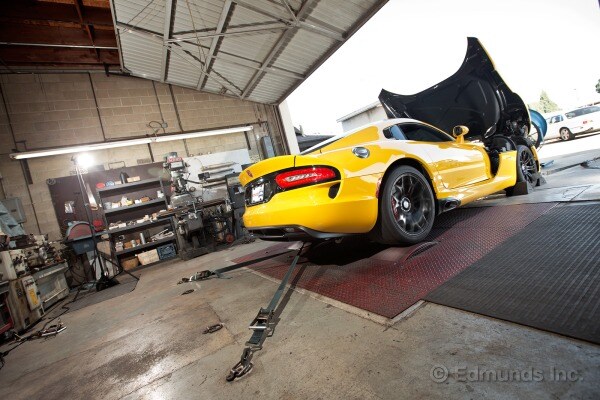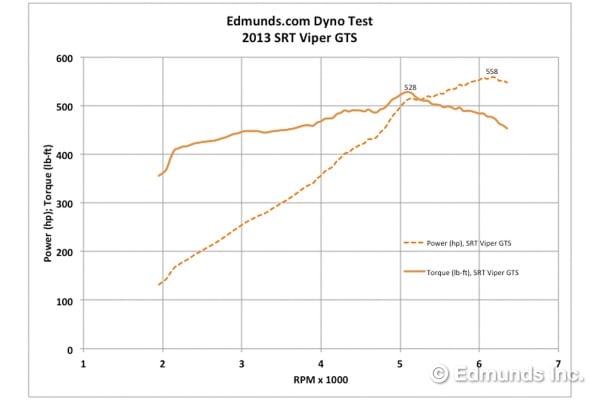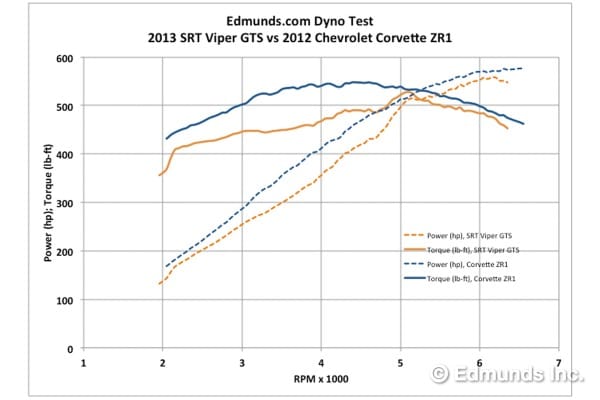
Few cars adhere to their ancestry more securely than the 2013 SRT Viper GTS. Here's a voluptuous rear-wheel-drive sports car offered exclusively with a manual gearbox that relies on sheer galactic-grade, normally aspirated cubic inches to deliver its thrust. The stars and stripes practically erupt out of its side pipes. Oh, and — side pipes!
Last go-round, Chrysler called this sports car "SRT10." Now it wants you to say its manufacturer is SRT, which is as likely to catch favor as The Rock's attempts to be called Dwayne. It's a freakin' Viper, and that's that.
Because what it needed was more power, Chrysler upped this latest Viper's output to 640 horsepower and 600 pound-feet of torque as measured at the engine's flywheel. We headed down to MD Automotive's Dynojet chassis dyno to glean more insights on the reptile's power delivery as measured at the wheels.

The Viper's 8.4-liter pushrod V10 power plant is a leviathan, its sheer acreage dictating the packaging of nearly everything else about the car. There are still just two valves per cylinder, but what this engine lacks in valve curtain area it makes up for with enormity. Yet the V10 is not entirely devoid of innovation, sporting an elaborate multipiece camshaft that allows independent adjustment of exhaust and intake valve events.
Our best premium fuel here in Southern California is lowly 91 octane. Normally this would be cause for some mild concern when it comes to a 600-hp engine. It is, however, likely that the Viper's big, understressed mill is less octane-sensitive than more highly strung ones. Here's what we measured on the chassis dyno:

Torque rises progressively between 2,000 and 5,000 rpm, reaching a maximum of 528 lb-ft at a relatively lofty 5,100 rpm. It noses over just as gradually, reaching its peak 558 hp just before the abrupt 6,400-rpm fuel cut. Big cubes mean lots of air no matter what the tach shows. More than 400 lb-ft is available at any revs above 2,200 rpm. Mat the gas right off idle and it's already producing north of 300 lb-ft of torque. Crazy, right?

Incredibly, the Viper is not the torquiest production car we've ever tested. In addition to a few luxury sedans, the Viper gets pipped by the 638-hp 2012 Chevrolet Corvette ZR1 that we happened to run on the dyno that same day. Have a look:

This is one of those cases where peak numbers definitely don't tell the whole story. Sure, the 'Vette squeaked out a few more ponies at the peak. But look at the difference in torque through the midrange — the ZR1's supercharged 6.2-liter V8 simply puts down a whole lot more of it than the Viper's aspro V10. At 3,600 rpm the ZR1 is belting out 85 lb-ft more than the Viper. Though the Viper enjoys 2.2 liters more displacement, it just can't ingest as much air as the ZR1's blower heaves through its valves.

With the windows down, the side pipes assault your eardrums with the V10's off-kilter, dueling-five-cylinder percussive pummeling. It's never been a pretty sound, but in this newest guise it doesn't remind you quite so much of brown delivery trucks. Want thrills? Relish the Viper's absurdly potent acceleration.

The ZR1 is no less vocal. Once its exhausts flap open midway through the rev range, the plastic fantastic's audio track wakes the hell up. In the confined space of the dyno room, the bellow grows downright ear-splitting.

Easter egg: As the Viper's tach starts to approach the rev limiter, the whole gauge gradually glows brighter and brighter red while the car's cartoon snake face emerges in the center. Yeah, it's goofy and over the top. This is a car with an 8.4-liter V10. You expected restraint?






The manufacturers provided Edmunds these vehicles for the purposes of evaluation.


